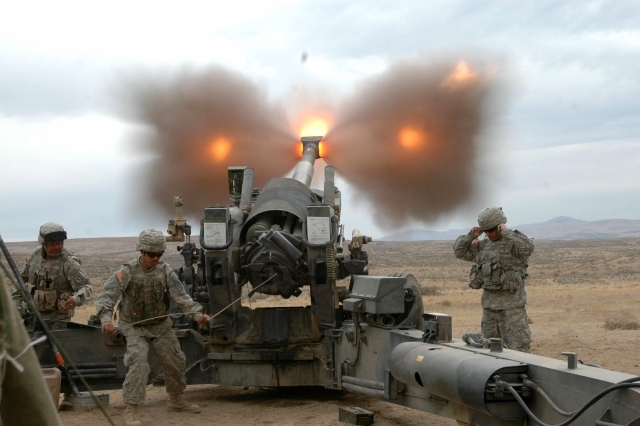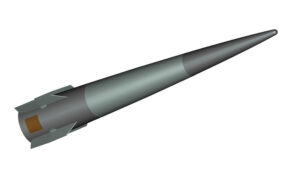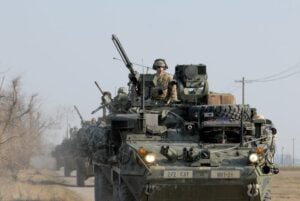Army Explores Anti-Ship Howitzers & Anti-Air Strykers
Posted on

Army 155 mm howitzer
ARLINGTON: New threats from Russia and China mean the Army must take on new missions — but it’s got almost no new money so the Army is looking at ways to modify existing systems to do some radically new things.
So imagine howitzers firing precision-guided cannon shells to shoot cruise missiles out of the sky or to sink ships on the South China Sea. Imagine networking existing sensors in new ways to counter Russian heavy jamming. Imagine eight-wheel-drive Stryker armored vehicles acting as mobile anti-aircraft guns.
 “One of the highlights that I was trying to emphasize is repurposing existing capability,” said Maj. Gen. John Rossi, head of the Army Fires Center at Fort Sill, speaking to me after his remarks to the Association of the US Army’s annual air and missile defense conference. “I see very promising potential for using something we already have” in new ways, he said, for less money and time than developing new weapons.
“One of the highlights that I was trying to emphasize is repurposing existing capability,” said Maj. Gen. John Rossi, head of the Army Fires Center at Fort Sill, speaking to me after his remarks to the Association of the US Army’s annual air and missile defense conference. “I see very promising potential for using something we already have” in new ways, he said, for less money and time than developing new weapons.
If this economy-minded “teach old dogs new tricks” approach sounds a lot like Secretary Ash Carter’s Strategic Capabilities Office, that’s not an accident. SCO is pushing the Hyper Velocity Projectile (HVP), a BAE Systems cannon shell with precision guidance that can be fired from Navy 5-inch deck guns or Army 155 millimeter howitzers. The Navy side is further along, but the Army has test-fired the 155 version of the HVP, Carter boasted recently.
“This is a high [priority] Secretary of Defense, DepSecDef interest item,” said David Markowitz, the Army’s assistant deputy chief of staff for operations, during an AUSA panel. HPV is even becoming a test case: Can we really field ground breaking disruptive technology fast?” he asked. “We need this type of capability….We realize it’s a high risk.”
BAE Systems’ HVP isn’t the only precision-guided cannon projectile out there, however, and air/missile defense isn’t the only applicable mission. Excalibur is Raytheon’s entry in the smart-artillery market, and it’s now available in a naval version. Such technology could also let land-based artillery attack targets at sea.

BAE Hyper Velocity Projectile (HVP)
The 155 mm howitzer is just one weapon being considered for “coastal artillery,” Rossi told me. Anti-ship projectiles could also be developed for the Multiple-Launch Rocket System (MLRS), which has a 43-mile range, or the Army Tactical Missile System (ATACMS), which ranges 185 miles.
What the Army is not studying, Rossi said, is buying anti-ship cruise missiles, which would be an entirely new weapons system rather than a modification of an existing one. That news will be a disappointment, if hardly unexpected, to legislators like House seapower chairman Randy Forbes and thinktanks like the Center for Strategic and Budgetary Assessments, which have advocated the US Army get into the shore-based cruise missile business to counter China’s growing navy.
But the Army just doesn’t have the funding to field an entirely new capability. Even employing the high-priority Hyper Velocity Projectile remains a concept at this point, Rossi emphasized, not a funded program.
There’s a cultural issue as well as a financial one. As much as outsiders might want the Army to revive its pre-World War II tradition of Coastal Artillery, modern soldiers’ anxieties don’t point out to sea. Instead, the service is increasingly concerned about threats from the air. (For fun and perspective, read this history of coastal and anti-aircraft artillery, featuring Colin’s great-grandfather.)
After the Cold War, “we took the ‘A’ out of ‘air and missile defense’ in many ways…and we focused on missile defense,” Rossi told the AUSA conference. The Army focused on shooting down ballistic missiles and assumed the Air Force would sweep the skies of enemy aircraft.
That assumption is no longer valid in the face of Russian and Chinese anti-access/area denial forces whose primary purpose is to keep American aircraft and ships at bay. The congressionally chartered National Commission on the Future of the US Army singled out short-range air defense (SHORAD) as a major Army weakness.
“What keeps everybody up at night over there is really the ‘A,’ the ‘air’ part in integrated air and missile defense, especially for my Ukrainian and Georgian counterparts,” said Col. Janell Eickhoff, who heads the Europe-based 10th Air and Missile Defense Command. “They talk about the Russians’ use of UAVs” to spot for massive artillery barrages.

Stryker vehicles from the Army’s 2nd Cavalry Regiment in Romania.
One of the Army’s initiatives to counter Russia is upgunning its eight-wheel-drive Stryker with a 30 mm automatic cannon. The original intent was to destroy light armored vehicles like the Russian BMP — but that’s not the only application, argued Markowitz: “We start to get 30mm Stryker airburst munitions, that might have some air defense capability.”
The new Russian way of war exploits not only drones but also electronic warfare — detecting, jamming, and deceiving enemy transmissions — to shut down Ukrainian communications or triangulate their locations. Pentagon leaders are deeply concerned that the US has lost its edge in electronic warfare, but reviving Army EW is a slow process. With a new Army offensive jammer seven years away, the service is instead emphasizing defense: It is experimenting with networking existing systems in new ways so they can better resist Russian-style jamming.
“The first step is how can we maximize and integrate all the current sensors,” said Lt Gen. David Mann, head of Army Space and Missile Defense Command. Then, he told, me, “No. 2, in addition to that, [is] how do we leverage [new] technology?”
 “We’ve had exercises out at White Sands [New Mexico] where we looked at different potential threat technologies and its impact on our sensors,” Mann told me. Traditionally, each air or missile defense battery relied on its own radar, and if that were jammed, the battery would be blind. “So you don’t rely on just one sensors, you look at multiple sensors…different types, different locations, different wavelengths,” he said. “[That way] Patriot doesn’t just rely on the Patriot radar, it’s able to take feeds from other radars whether it’s Sentinel or you name it, and we’ve proven that it works.”
“We’ve had exercises out at White Sands [New Mexico] where we looked at different potential threat technologies and its impact on our sensors,” Mann told me. Traditionally, each air or missile defense battery relied on its own radar, and if that were jammed, the battery would be blind. “So you don’t rely on just one sensors, you look at multiple sensors…different types, different locations, different wavelengths,” he said. “[That way] Patriot doesn’t just rely on the Patriot radar, it’s able to take feeds from other radars whether it’s Sentinel or you name it, and we’ve proven that it works.”
The network to link all these sensors together is called IBCS — Integrated Air & Missile Defense Battle Command System — which remains the No. 1 priority for Army air and missile defense modernization. While IBCS will be able to accommodate new weapons, its primary purpose is to make more efficient and effective use of existing ones. With total air and missile defense procurement and R&D at $1.8 billion in the 2017 budget, there’s not much money for new stuff.
Subscribe to our newsletter
Promotions, new products and sales. Directly to your inbox.
